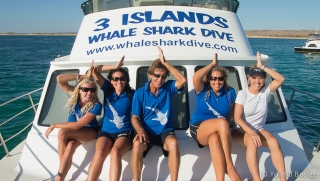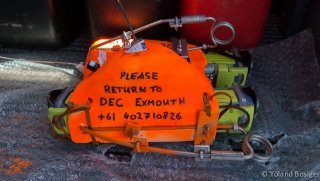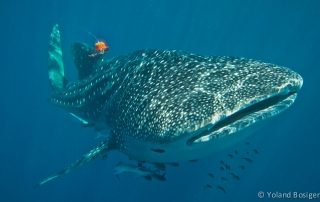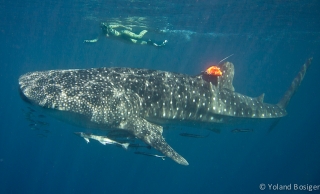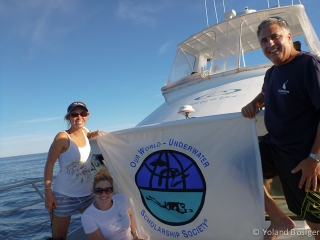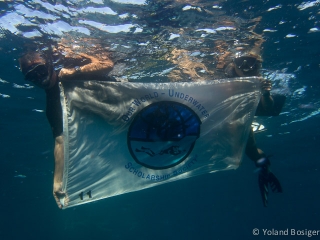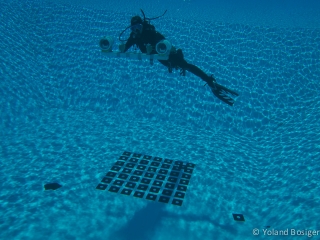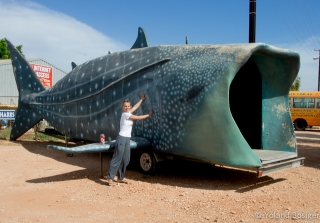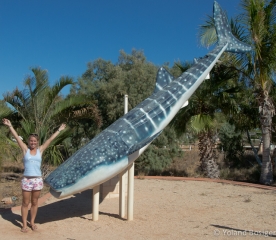Brad and I arrived in Learmouth airport and caught a bus to the town of Exmouth. The first thing that struck me about this part of the world was the landscape. Red desert meets sparkly blue water – wow! I remember thinking that this place truly feels like Australia. Our stop was the Novatel Hotel where Brad would be staying and I would stay until I relocated to the Lighthouse Caravan Park. We then headed to get some groceries where I was stoked to find that Exmouth has developed a no plastic bag policy. I only hope that more towns in Australia and the world can follow Exmouth’s lead here.
I spent the next couple of days helping Sherrie Chambers who is a current Honours student with Brad at Murdoch University in Western Australia. Sherrie and I had two fabulous days with Three Islands Whale Shark Dive and Ningaloo Blue, who both generously agreed to have me out for a day. These boats allow tourists to have amazing up-close-and-personal experiences with the whale sharks while still insuring that the sharks are respected and not disturbed. I remember the feeling of admiration and amazement the first time I saw a whale shark at Ningaloo. This particular male was so peaceful and majestic in the water, and to think that others like him had swum unchanged for 150 million years was mind blowing. I hovered there in the water feeling completely insignificant until I was told to get back on the boat.
It was time to do some work and I had a great time helping Sherrie measure some of the whale sharks. Each time a shark was spotted, Sherrie or I would jump into the water, stereo camera in hand, and try to take video with the entire shark in frame. Easier said than done sometimes and often it was quite a workout keeping up!! Once the video is taken, Sherrie uses specialised software to derive accurate length measurements of the whale sharks. Overall, I was completely astounded by the sheer amount of megafauna that we saw those two days. Not only did we swim with whale sharks, but we also saw manta rays, humpback whales and dolphins from the boat – awesome!
The main motivation for Brad’s trip to Ningaloo this month was to tag whale sharks with Peter and Niko from Customized Animal Tracking Solutions (CATS). Peter and Niko have recently founded CATS, which is a company designed specifically to develop customized tags for a diversity of different terrestrial and marine animals. It seemed like every time I talked to these guys, they had another story of incredible animals they had tagged, including dugongs, sperm whales, sunfish, jellyfish and penguins, just to name a few. Today we were going to deploy a Daily Diary tag prototype, which measures a number of variables including acceleration, temperature, depth, and light levels. Niko and Peter have also integrated “CATS CAMS” (small video cameras) in the tag so that the environment can be observed from a whale sharks point of view
We headed out from Tantabiddi boat harbour and Peter and Niko were busily getting their Daily Diary tags ready to be deployed. Finally the spotter plain found a shark and there was a flurry of activity to get everything finalised. “Hold on, wait, okay, now,” shouted Brad and we were in. A massive 9 m female whale shark was swimming just in front of us and Niko swam towards the dorsal fin, releasing the tag onto the shark. Each tag is attached to a small clamp, which fits neatly around the front of the dorsal fin (see above pic). After our first successful deployment it was time for the next shark, which was a super inquisitive 5 m male. This beautiful shark continued to swim around us until we had to leave that afternoon.
The Daily Diary tags we were using store data on the tag itself which means that recovering the tag is pretty important! After a couple of hours, a small metal clasp (Galvanized Time Release) corrodes, allowing the tag to detach and float to the surface. Throughout the next few weeks we spent a lot of time trying to detect the tag using a directional hydrophone, which is used to detect pings from a small acoustic tag imbedded in the daily diary. We also used a VHF receiver antenna (Yagi) to detect radio signals from the tag when it was floating on the surface. You definitely build up your biceps holding that Yagi – it’s heavy!
During my stay at Exmouth, I also learned how to approve and spot whale shark photo ID pics that had been entered into the ECOCEAN Photo Identification Library. The great thing about ECOCEAN is that it allows ordinary people to contribute to our understanding of whale sharks by taking pictures. Ideally pictures should be of the left side, behind the gills. These images can then be uploaded to www.whaleshark.org and spot patterns are compared to hundreds of others in the whale shark database using NASA Hubble telescope technology for mapping stars. Over the next couple of days, I learned all about the program and managed to catalogue two previously observed sharks and two new sharks.
One of the most memorable experiences was definitely being able to watch whale shark feeding at dusk. We had heard that aggregations of whales sharks had been feeding near the Merion Islands and we headed out with the Department of Fisheries Boat to try our luck at finding them (for more info on the aggregations see: http://www.perthnow.com.au/news/western-australia/group-of-25-whale-sharks-a-first-for-ningaloo/story-e6frg13u-1226369724822.) It was almost dark and we were ready to give up when we finally saw what we were waiting for. Two whale sharks were on the surface with their mouths wide open gulping in tiny krill. Brad, Niko, Peter and I jumped in and there one was, coming straight towards us. The whale shark was so focused on feeding that it had not even noticed our presence. I quickly kicked away and before I knew it the whale shark had passed leaving a massive stream of bubbles in its wake. Unlike in the daytime, this whale shark was swimming at high speed and I was very grateful for my Tusa fins which allowed me to just keep up. I glanced down for a moment and noticed that there were also a huge group of manta rays also feeding on krill – wow! Up ahead Niko had managed to tag the whale shark and it continued to feed unperturbed. Out of the total seven Daily Diary tags deployed on the trip we managed to recover six, making it an extremely successful tagging effort.
My last couple of days were spent helping Brad, Niko, and Peter attach some acoustic tags to the whale sharks. We had one incredibly successful day where we managed to tag 4 sharks in total. I took on the role of whale shark spotter which involves jumping into the water first and signalling to the boat about the sharks behaviour (i.e. whether it is on the surface or diving) (I felt very epic, haha). I also took photo ID shots while Brad got some skin samples of the sharks. At one point we had two whale sharks around us and I remember not really knowing which way to look. Sadly, my time at Ningaloo was coming to an end but luckily there was still some time to help out with Sherrie’s Stereo Video calibration and hassle a couple of model whale sharks.
I had such a wonderful time at Ningaloo and miss it already. Thanks so much to Brad Norman for getting me out on the boat at ever opportunity and treating me like a extremely valuable member of his team the entire trip. Massive thanks to Sherrie Chambers for patiently teaching me and for putting up with me in our tent at the lighthouse caravan park. A huge thanks to Peter, Niko, and Rowland for providing fantastic company, knowledge, and entertainment. Your guys rock! Finally thanks to everyone who made this trip possible: Steve, Jayne and all our fantastic sponsors.





